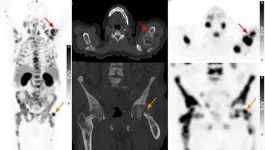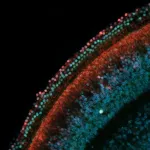(Press-News.org) A federally funded study, led by University of Cincinnati researcher Nalinikanth Kotagiri, looks to develop a new imaging method that can identify certain types of lung infections — in real time — in order to speed up treatment for critically ill patients.
Kotagiri, an associate professor of pharmaceutical sciences at the UC James L. Winkle College of Pharmacy, has been awarded a five-year $3 million, R01 grant from the National Heart, Lung, and Blood Institute (NHLBI) to develop and study the effectiveness of different kinds of injectable probes (metallic contrast agents) that would collect at the site of the infection and immediately light up under a nuclear imaging machine, known as a PET scan.
Currently, radiologists use chest X-rays to confirm the diagnosis of pneumonia and other infections in the lungs. An X-ray, however, cannot determine the specifics of the infection or whether the infection is bacterial, viral or fungal. A specific diagnosis can only be determined by a pathologist, after culturing a sample of lung tissue which is collected from an invasive procedure (called a bronchoscopy) and takes time, typically 2-3 days.
Critically ill patients, however, such as those with infectious pneumonia and underlying conditions such as chronic obstructive pulmonary disease (COPD), might not have time to spare, says Kotagiri.
“Our solution is to use imaging to identify what is causing the pneumatic episode,” within hours, to hasten a treatment plan, he says.
An added benefit, he says, is that the contrast agent development process “doesn’t require elaborate processing or preparation time.” This is critical as development of contrast agents can be time-consuming and complicated. A simple and fast process is expected to reduce preparation time in a clinical laboratory and potentially enable adoption of the technology in a clinical setting.
With this study, in animal models, Kotagiri and colleagues will only be looking at bacterial and viral pneumonias in conjunction with COPD, but the imaging approach has the potential to apply to other types of infections such as fungal infections or conditions such as cystic fibrosis.
Imaging the patient after treatment, Kotagiri says, could also identify whether the patient is responding to medications such as antibiotics. Imaging could also potentially aid in determining the right antibiotics to use, targeting the pathogens that were identified.
The collaborators on this project include experts in COPD and lung diseases: Francis McCormack, MD, a pulmonologist, and Michael Borchers, PhD, at the University of Cincinnati. Changchun Xie, PhD, at the University of Cincinnati is the team’s biostatistician, and Suzanne Lapi, PhD, at the University of Alabama-Birmingham will provide the radiochemistry expertise to optimize contrast agent development.
#
END
UC study focus: faster, more accurate way to diagnose lung infections
UC researchers say that imaging has the potential to identify specific lung infections in real time — instead of taking 2-3 days
2023-08-14
ELSE PRESS RELEASES FROM THIS DATE:
Illinois professor describes how whaling shaped U.S. culture even after petroleum replaced it
2023-08-14
CHAMPAIGN, Ill. — The whaling industry helped drive industrialization in the 19th century, with whale oil used to light lamps and lubricate machinery. Even after petroleum replaced whale oil as an energy source in the U.S., whaling continued to be part of our cultural imagination and helped develop the idea of an energy industry, said University of Illinois Urbana-Champaign English professor Jamie L. Jones.
Her new book, “Rendered Obsolete: The Afterlife of U.S. Whaling in the Petroleum Age,” examines the influence of a dying industry during the massive energy transition from the organic fuel sources of the 19th century, including whale oil and wood, to the extraction of fossil ...
In battle against pancreatic cancer, grant-funded H-FIRE study offers hope
2023-08-14
Only about 10 percent of patients survive as long as five years after a diagnosis of pancreatic cancer.
“Pancreatic cancer is very hard to treat,” said Irving Coy Allen, professor of inflammatory diseases in the Department of Biomedical Sciences and Pathology at the Virginia-Maryland College of Veterinary Medicine. “It's one of the top five deadliest cancers in the U.S. And it's deadly because by the time you find out that you have a tumor, it's usually metastasized. You can usually treat the local tumor, but how do you treat the metastatic lesions?”
The National Institutes of Health has awarded $2.6 million to a Virginia Tech team ...
Consumers who buy cannabis products containing HHCs could be getting less than they hoped for
2023-08-14
Key takeaways
In the fast-growing marketplace for recreational marijuana and related products, products containing cannabinoids called HHCs are gaining popularity.
The neurological and physiological effects of HHCs are not well understood.
A new study by UCLA chemists is the first to explain how well HHCs bind to receptors in the human body; the scientists also devised a safer way to produce HHCs than the current standard process.
As more of the nation has adopted legal marijuana, a glut of products has emerged in dispensaries that contain the psychoactive ingredient in marijuana, ...
A new way to evaluate the impact of medical research
2023-08-14
Scientific journals and research papers are evaluated by a metric known as their “impact factor,” which is based on how many times a given paper is cited by other papers. However, a new study from MIT and other institutions suggests that this measure does not accurately capture the impact of medical papers on health outcomes for all patients, particularly those in low- or middle-income countries.
To more fully capture a paper’s impact on health, metrics should take into account the demographics of the researchers who performed the ...
Department of Energy announces $112 million for research on computational projects in fusion energy sciences
2023-08-14
WASHINGTON, D.C. - Today, the U.S. Department of Energy’s (DOE) Office of Science (SC), announced $112 million in funding for 12 projects that focus on collaborations among fusion scientists, applied mathematicians, and computer scientists to maximize the use of high performance computing, including exascale computers.
The Scientific Discovery through Advanced Computing (SciDAC) program pairs the Fusion Energy Sciences (FES) program with the Advanced Scientific Computing Research (ASCR) program to explore solving complex ...
Cancer-infecting virus ‘warms up’ cold tumors and improves immunotherapy
2023-08-14
Equipping cancer-infecting, or oncolytic, viruses with tumor-inhibiting genetic cargo stimulates the immune system and helps immunotherapy to shrink or completely clear aggressive tumors in mice, according to a new study in the Journal of Experimental Medicine led by University of Pittsburgh and UPMC researchers. The results pave the way for clinical trials combining oncolytic viruses with immunotherapy.
Oncolytic viruses are genetically modified viruses that target rapidly dividing tumor cells while avoiding normal cells. Oncolytic viruses were originally designed to directly kill cancer cells, but researchers later ...
PSMA PET/CT waives the need for pre-imaging biopsy in elderly patients
2023-08-14
Reston, VA—In elderly patients with suspected prostate cancer, PSMA PET/CT can diagnose advanced disease and aid in therapy selection without the need for a biopsy. Published in the July issue of The Journal of Nuclear Medicine, this new research demonstrates how imaging with PSMA PET/CT can potentially reduce the number of prostate biopsies and associated complications in the elderly while providing accurate staging data.
68Ga-PSMA PET/CT has gained acceptance as a highly sensitive and specific imaging modality for evaluating the extent of disease in prostate cancer patients. In general, PSMA PET/CT is indicated when intermediate ...
How did South African healthcare workers cope during the pandemic?
2023-08-14
A new study by UC Berkeley Anthropology Professor Andrew Wooyoung Kim reveals resilient coping mechanisms used by healthcare workers during the COVID-19 pandemic in metro Johannesburg, South Africa.
Titled “Coping strategies employed by public psychiatric healthcare workers during the COVID-19 pandemic in southern Gauteng, South Africa,”(link is external) Kim's paper was published in PLOS ONE in August. It explores the diverse coping strategies employed by public psychiatric healthcare workers during ...
Scientists outline a new strategy for understanding the origin of life
2023-08-14
Despite decades of progress, the origin of life remains one of the great unsolved problems in science. “The most basic features of biology, that organisms are made of cells, that they pass genetic information through DNA, that they use protein enzymes to run their metabolism, all emerged through specific processes in very early evolutionary history,” says Aaron Goldman, Associate Professor of Biology at Oberlin College. “Understanding how these most basic biological systems first took shape will not only give us greater insight into how life works at the most fundamental level, but what life actually is in the ...
USC Stem Cell studies tune into hearing regeneration
2023-08-14
A deafened adult cannot recover the ability to hear, because the sensory hearing cells of the inner ear don’t regenerate after damage. In two new studies, partially funded by the National Institutes of Health and published in the Proceedings of the National Academy of the Sciences (PNAS), USC Stem Cell scientists explain why this is the case and how we might be able to change it.
“In the non-sensory supporting cells of the inner ear, key genes required for conversion to sensory cells are shut off through a process ...
LAST 30 PRESS RELEASES:
Sports injuries sustained during your period might be more severe
World's first successful 2 Tbit/s free-space optical communication using small optical terminals mountable on satellites and HAPS
Can intimate relationships affect your heart? New study says ‘yes’
Scalable and healable gradient textiles for multi‑scenario radiative cooling via bicomponent blow spinning
Research shows informed traders never let a good climate crisis go to waste
Intelligent XGBoost framework enhances asphalt pavement skid resistance assessment
Dual-function biomaterials for postoperative osteosarcoma: Tumor suppression and bone regeneration
New framework reveals where transport emissions concentrate in Singapore
NTP-enhanced lattice oxygen activation in Ce-Co catalysts for low-temperature soot combustion
Synergistic interface engineering in Cu-Zn-Ce catalysts for efficient CO2 hydrogenation to methanol
COVID-19 leaves a lasting mark on the human brain
Scientists use ultrasound to soften and treat cancer tumors without damaging healthy tissue
Community swimming program for Black youth boosts skills, sense of belonging, study finds
Specific depressive symptoms in midlife linked to increased dementia risk
An ‘illuminating’ design sheds light on cholesterol
Who is more likely to get long COVID?
Study showcases resilience and rapid growth of “living rocks”
Naval Research Lab diver earns Office of Naval Research 2025 Sailor of the Year
New Mayo-led study establishes practical definition for rapidly progressive dementia
Fossil fuel industry’s “climate false solutions” reinforce its power and aggravate environmental injustice
Researchers reveal bias in a widely used measure of algorithm performance
Alcohol causes cancer. A study from IOCB Prague confirms damage to DNA and shows how cells defend against it
Hidden viruses in wastewater treatment may shape public health risks, study finds
Unlock the power of nature: how biomass can transform climate mitigation
Biochar reshapes hidden soil microbes that capture carbon dioxide in farmland
Reducing saturated fat intake shows mortality benefit, but only in high-risk individuals
Manta rays create mobile ecosystems, study finds
Study: Mixed results in using lipoic acid to treat progressive multiple sclerosis
Norbert Holtkamp appointed director of Fermi National Accelerator Laboratory
New agentic AI platform accelerates advanced optics design
[Press-News.org] UC study focus: faster, more accurate way to diagnose lung infectionsUC researchers say that imaging has the potential to identify specific lung infections in real time — instead of taking 2-3 days





